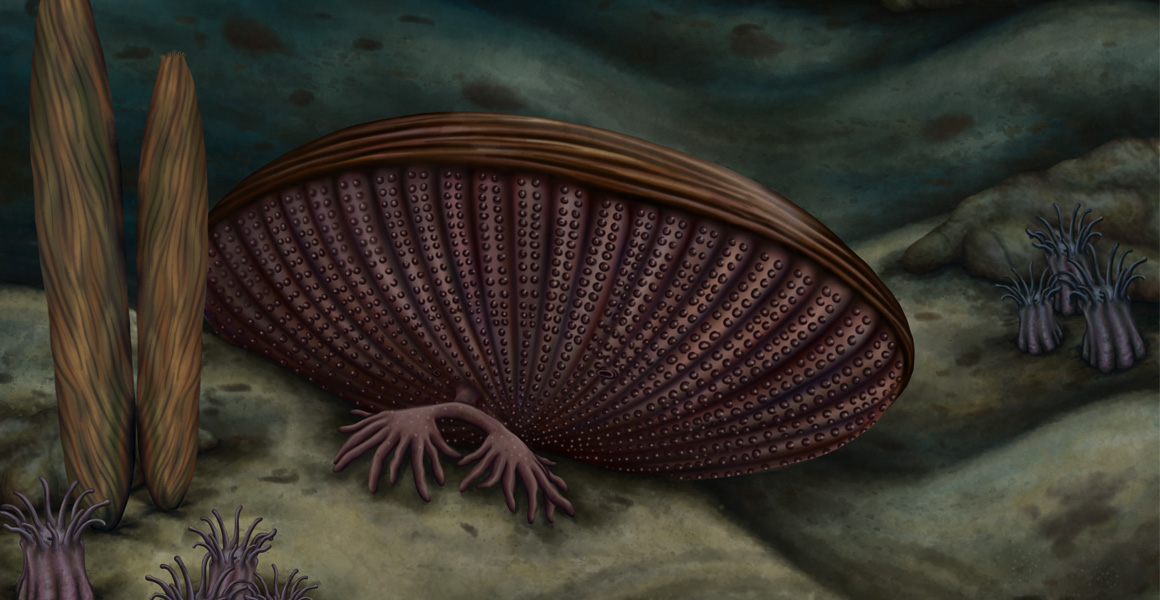Analysis of well-preserved Rotadiscus fossils sheds light on the origin and evolution of major groups alive today.

Rotadiscus grandis lived 518 million years ago during the Cambrian period. Image © Holly Sullivan
Scientists have described new specimens of the enigmatic animal Rotadiscus from an exceptionally preserved fossil assemblage in China. Their analysis revealed new anatomical details that could be key to understanding how chordates – the major group that includes humans – evolved.
The fossils date to the Cambrian, a key geological period beginning approximately half a billion years ago. This was a pivotal point in the evolution of life which saw the emergence of nearly all the major groups of animals seen today.
Following their research, scientists, including Dr Imran Rahman, Principal Researcher at the Natural History Museum and Dr Frankie Dunn, Research Fellow at Oxford University Museum of Natural History, have classified Rotadiscus and its closest fossil relatives as early members of an animal group called the Ambulacraria, which also includes modern invertebrates like starfish, sea urchins and acorn worms.
Ambulacraria sit within the superphylum Deuterostomia, as do Chordata (the group humans and other vertebrates belong to).
Deuterostomes are one of the most widely divergent groups of animals – including starfish, pandas, crows, snakes and humans – making it difficult to predict ancestral characters. As a result, the origin and earliest evolution of the group has long remained ambiguous.
The analysis revealed that Rotadiscus exhibited a combination of ambulacrarian and chordate characteristics, including a previously unknown double spiral structure. Up to this point, there had been competing theories on how to classify Rotadiscus.
Dr Iman Rahman, Principal Researcher at the Natural History Museum, and lead author of the study, said: ‘This is the first time we have been able to confidently place a group of fossils as early ambulacrarians, filling an important gap in the tree of life.
‘This research demonstrates once again the vital role ancient fossils play in mapping the evolutionary journey of animals still alive today – including the major group that humans belong to.’
It also allowed the scientists to conclude that the post-anal tails of chordates and hemichordates were acquired independently.
Dr Frankie Dunn, Research Fellow at Oxford University Museum of Natural History, said: ‘Work on these fossils helped us to resolve a palaeontological mystery. Rotadiscus sheds light on the origin of major animal groups today, including starfish, and tells us what their ancestor may have looked like more than half a billion years ago.’
The paper Cambrian stem-group ambulacrarians and the nature of the 2 ancestral deuterostome is published in Current Biology.
ENDS
Notes to editors
Natural History Museum media contact:
Tel: +44 (0)20 7942 5654 / 07799690151
Email: press@nhm.ac.uk
Images and press release are available to download here: Press Pack
The Natural History Museum is both a world-leading science research centre and the most-visited indoor attraction in the UK. With a vision of a future in which both people and the planet thrive, it is uniquely positioned to be a powerful champion for balancing humanity’s needs with those of the natural world.
It is custodian of one of the world’s most important scientific collections comprising over 80 million specimens accessed by researchers from all over the world both in person and via over 50 billion digital data downloads to date. The Museum’s 350 scientists are finding solutions to the planetary emergency from biodiversity loss through to the sustainable extraction of natural resources.
The Museum uses its global reach and influence to meet its mission to create advocates for the planet - to inform, inspire and empower everyone to make a difference for nature. We welcome millions of visitors through our doors each year, our website has had 17 million visits in the last year and our touring exhibitions have been seen by around 20 million people in the last 10 years.
About Oxford University Museum of Natural History
Founded in 1860 as the centre for scientific study at the University of Oxford, the Museum of Natural History now holds the University’s internationally significant collections of entomological, geological and zoological specimens. Housed in a stunning Pre-Raphaelite-inspired example of neo-Gothic architecture, the Museum’s growing collections underpin a broad programme of natural environment research, teaching and public engagement.
Contact
Weekdays: +44 (0)20 7942 5654
Evenings and weekends:
+44 (0)7799 690 151
Email: press@nhm.ac.uk
Don't miss a thing
Receive email updates about our news, science, exhibitions, events, products, services and fundraising activities. We may occasionally include third-party content from our corporate partners and other museums. We will not share your personal details with these third parties. You must be over the age of 13. Privacy notice.
Follow us on social media